力学专业英语部分翻译孟庆元)
力学专业英语08
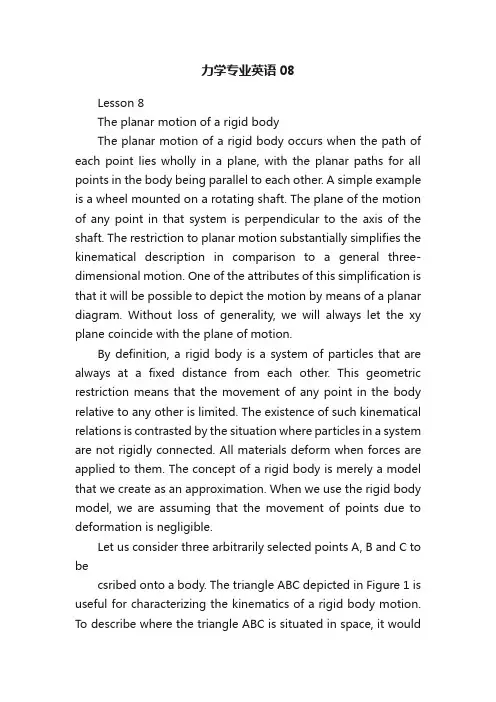
力学专业英语08Lesson 8The planar motion of a rigid bodyThe planar motion of a rigid body occurs when the path of each point lies wholly in a plane, with the planar paths for all points in the body being parallel to each other. A simple example is a wheel mounted on a rotating shaft. The plane of the motion of any point in that system is perpendicular to the axis of the shaft. The restriction to planar motion substantially simplifies the kinematical description in comparison to a general three-dimensional motion. One of the attributes of this simplification is that it will be possible to depict the motion by means of a planar diagram. Without loss of generality, we will always let the xy plane coincide with the plane of motion.By definition, a rigid body is a system of particles that are always at a fixed distance from each other. This geometric restriction means that the movement of any point in the body relative to any other is limited. The existence of such kinematical relations is contrasted by the situation where particles in a system are not rigidly connected. All materials deform when forces are applied to them. The concept of a rigid body is merely a model that we create as an approximation. When we use the rigid body model, we are assuming that the movement of points due to deformation is negligible.Let us consider three arbitrarily selected points A, B and C to becsribed onto a body. The triangle ABC depicted in Figure 1 is useful for characterizing the kinematics of a rigid body motion. To describe where the triangle ABC is situated in space, it wouldbe sufficient to know the coordinates locating point A, and the angle φbetween the x axis and side AB. From this information, the position of a rigid body at any instant is defined by the absolute position of a point in the body and the angular orientation of any line in the body.Our knowledge of the information required to locate the position of a rigid body permits us to describe how the position change with time. Figure 1 depicts the position of triangle ABC at an instant subsequent to the original position of the triangle indicated by the dashed lines. The distances Δx and Δy describe the movement of point A, and Δφdescribes the angle of rotation of line AB. By the definition of a rigid body we know that the angles between all sides of the triangle are constant. It follows then that each line undergoes the same rotation. Hence, angular motion is an overall property of the motion of the body. It is the same regardless of which points in the body are being discussed.Now ,suppose that the movement of point A is specified. In addition to this movement, points B and C may move relative to point A. Because the angular motion is an overall property, the radial lines from point A to points B and C undergo the same rotation. In other words, each point moves in a circular path relative to point A. Therefore, we may concludethatThe motion of a rigid body consists of a superposition of two movements. The first par consists of a movement of all points following the motion of an arbitrarily selected point in the body. The second movement is a rotation about the selected point in which all lines rotate by the same amount.This statement is known as Chasle’s theorem.Special terms are used to describe the motion of rigid bodies.One simple type of motion occurs when every line in the body retains its original orientation, that is , there is no rotation. This is called a translation. Another simple type of motion occurs when one point in the body is fixed in space. Chasle’s theorem states that the motion of the body may be considered to consists solely of a rotation about the fixed point, this is called a pure rotation, Chasle’s theorem may be reworded to state that the motion of a rigid body is the superposition of a translation of an arbitrary point and a pure rotation about that point.Suppose that the motion of point A in the rigid body shown in Figure 2 is known, as is the angular rotation of the body, ω. Point B is an arbitrarily chosen point whose motion we seek. As shown in Fugure 2 the vectors and denote the positions of points A and B respectively. Note that ωis independent of the choice for points A and B, because Chasle’s theorem states that the rotation is the same for all lines in arigid body. The absolute value of ωis called the angular speed of the rigid body.The qualitative insight provided by Chasle’s theorem will enable us to form algebraic relations for determining the velocities and accelerations of points on a rigid body. The relationship between the absolute motions of points A and B is readily formed by referring to the position vectors depicted in figure 2, i.e. In the above equations (2) and (3) ,the velocity and acceleration of point A are denoted by V A and a A respectively. The symbols V B and a B are similarly defined for point B. The vector ωis the angular velocity of the body, and a is the angular acceleration. Both vectors are perpendicular to the plane of motion, so they are parallel to the axis for the rotational portion of the motion. As usual, the angular unit forωand a must beradians.。
工程力学专业英语翻译
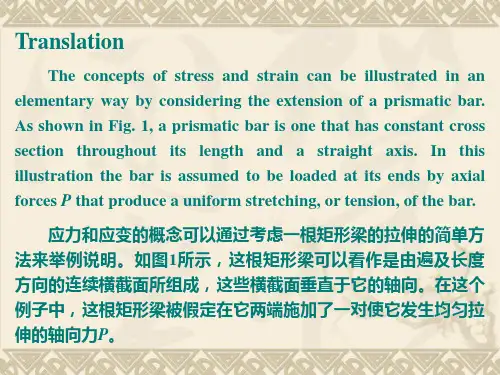
When a material exhibits a linear relationship between stress and strain, it is said to be linear elastic. This is an extremely important property of many solid materials, including most metals, plastics, wood, concrete, and ceramics. The linear relationship between stress and strain for a bar in tension can be expressed by the simple equation ζ=Eε (3) in which E is a constant of proportionality known as the modulus of elasticity for the material. 当一种材料的应力与应变表现出线性关系时,我们称这种材 料为线弹性材料。这是许多固体材料的一个极其重要的性质,这 些材料包括大多数金属,塑料,木材,混凝土和陶瓷。对于被拉 伸的梁来说,这种应力与应变之间的线性关系可以用简单方程(3) ζ= Eε 来表示,这里E是一个已知的比例常数,即该材料的弹性模 量。
方程(1) 用于求解在梁中均匀分布的应力问题。它表示了应力 的单位是力除以面积。正如我们在图1中所看到的,当梁被力P拉 伸的时候,生成的应力是拉应力;如果力的方向被颠倒,导致梁 被压缩时,产生的应力被称为压应力。
A necessary condition for Eq.(1) to be valid is that the stress ζ must be uniform over the cross section of the bar. This condition will be realized if the axial force P acts through the centroid of the cross section. When the load P does not act at the centroid, bending of the bar will result, and a more complicated analysis is necessary. At present, however, it is assumed that all axial forces are applied at the centroid of the cross section unless specifically stated to the contrary. Also, unless stated otherwise, it is generally assumed that the weight of the object itself is neglected, as was done when discussing the bar in Fig.1.
力学专业英语资料(一)考研必备
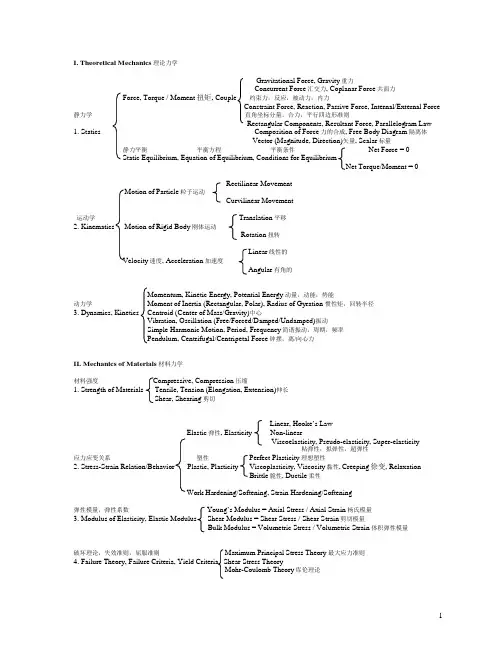
I. Theoretical Mechanics理论力学Gravitational Force, Gravity重力Concurrent Force汇交力, Coplanar Force共面力Force, Torque / Moment扭矩, Couple 约束力,反应,被动力,内力Constraint Force, Reaction, Passive Force, Internal/External Force 静力学直角坐标分量,合力,平行四边形准则Rectangular Components, Resultant Force, Parallelogram Law 1. Statics Composition of Force力的合成, Free Body Diagram隔离体Vector (Magnitude, Direction)矢量, Scalar标量静力平衡平衡方程平衡条件Net Force = 0Static Equilibrium, Equation of Equilibrium, Conditions for EquilibriumNet Torque/Moment = 0Rectilinear MovementMotion of Particle粒子运动Curvilinear Movement运动学 Translation平移2. Kinematics Motion of Rigid Body刚体运动Rotation扭转Linear线性的Velocity速度, Acceleration加速度Angular有角的Momentum, Kinetic Energy, Potential Energy动量,动能,势能动力学Moment of Inertia (Rectangular, Polar), Radius of Gyration惯性矩,回转半径3. Dynamics, Kinetics Centroid (Center of Mass/Gravity)中心Vibration, Oscillation (Free/Forced/Damped/Undamped)振动Simple Harmonic Motion, Period, Frequency简谐振动,周期,频率Pendulum, Centrifugal/Centripetal Force钟摆,离/向心力II. Mechanics of Materials材料力学材料强度 Compressive, Compression压缩1. Strength of Materials Tensile, Tension (Elongation, Extension)伸长Shear, Shearing剪切Linear, Hooke’s LawElastic弹性, Elasticity Non-linearViscoelasticity, Pseudo-elasticity, Super-elasticity粘弹性,拟弹性,超弹性应力应变关系塑性 Perfect Plasticity理想塑性2. Stress-Strain Relation/Behavior Plastic, Plasticity Viscoplasticity, Viscosity黏性, Creeping徐变, RelaxationBrittle脆性, Ductile柔性Work Hardening/Softening, Strain Hardening/Softening弹性模量,弹性系数 Young’s Modulus = Axial Stress / Axial Strain杨氏模量3. Modulus of Elasticity, Elastic Modulus Shear Modulus = Shear Stress / Shear Strain剪切模量Bulk Modulus = Volumetric Stress / Volumetric Strain体积弹性模量破坏理论,失效准则,屈服准则 Maximum Principal Stress Theory最大应力准则4. Failure Theory, Failure Criteria, Yield Criteria Shear Stress TheoryMohr-Coulomb Theory库伦理论Shear Force剪力, Bending Moment弯矩, Flexural Load弯曲荷载梁 Bending Stress弯曲应力, Normal Stress正应力, Shear Stress剪应力 (Horizontal/Longitudinal, Vertical/Transverse)5. Beam Neutral Axis中性轴, Flexure屈曲, Deflection挠曲Cantilever Beam悬臂梁, Simply Supported Beam简支梁, Pin-end, Fixed End固定端Uniformly/Linearly Distributed Load均布荷载, Concentrated Load集中荷载Buckling屈曲系数, Euler’s Equation欧拉方程6. Column 长细比,有效长度,临界荷载,偏心率Slenderness Ratio, Effective Length, Critical Load/Stress, Eccentricity RatioTension弹力, Compression压缩, Uniaxial/Axial Load单轴荷载7. Shaft杆, Rod长杆, Bar Inner/Outer Diameter内/外径Torsion扭转, Torque扭矩, TwistingRadial Distance辐射距离平面应变平面应力双向应力(单轴,三轴)应变能最大/小主应力8. Plane Strain, Plane Stress, Biaxial Stress (Uniaxial, Triaxial), Strain Energy, Major (Minor) Principal Stress Deformation变形, Displacement位移, Deflection偏向Stiffness, Rigidity刚度, Hardness硬度, Flexibility弹性, ComplianceDynamic Loading动力荷载, Cyclic/Fluctuating Loading脉冲荷载, Fatigue疲劳度Thermal Stress热应力/Strain/Deformation, Coefficient of Thermal Expansion热膨胀系数Factor of Safety安全系数, Safety FactorLimit State Design极限状态设计 (Ultimate Limit State极限状态, Serviceability Limit State正常使用极限状态), Probabilistic Design概率设计III. Structural Mechanics, Structural AnalysisRod, Shaft, Bar构件Beam, Girder1. Structural Element Column, PillarPlate, Shell, MembraneShear Wall, Shear Panel2. Truss构架, 3-hinge Arch, Rigid Frame刚性框架 (Joint节点, Pin-Joint, Hinge, Node)3. Statically Determinate静定, Statically Indeterminate超静定, Degree of Static Indeterminacy, N-fold Statically Indeterminate, Degree of Freedom自由度虚功原理 Virtual Displacement, (Matrix) Displacement Method, Stiffness Method4. Virtual Work Principle Virtual Force, (Matrix) Force Method, Flexibility MethodFinite Element MethodIV. Theory of Elasticity(Differential) Equilibrium Equation, Physical Equation, Compatibility/Geometrical EquationBoundary Conditions。
力学,流体力学,固体力学词汇英语翻译

力学,流体力学,固体力学词汇英语翻译力学,流体力学,固体力学英语词汇翻译牛顿力学Newtonian mechanics经典力学classical mechanics静力学statics运动学kinematics动力学dynamics动理学kinetics宏观力学macroscopic mechanics,macromechanics 细观力学mesomechanics微观力学microscopic mechanics,micromechanics 一般力学general mechanics固体力学solid mechanics流体力学fluid mechanics理论力学theoretical mechanics应用力学applied mechanics工程力学engineering mechanics实验力学experimental mechanics计算力学computational mechanics理性力学rational mechanics物理力学physical mechanics地球动力学geodynamics力force作用点point of action作用线line of action力系system of forces力系的简化reduction of force system等效力系equivalent force system刚体rigid body力的可传性transmissibility of force平行四边形定则parallelogram rule力三角形force triangle力多边形force polygon零力系null-force system平衡equilibrium力的平衡equilibrium of forces平衡条件equilibrium condition平衡位置equilibrium position平衡态equilibrium state分析力学analytical mechanics拉格朗日乘子Lagrange multiplier拉格朗日[量] Lagrangian拉格朗日括号Lagrange bracket循环坐标cyclic coordinate循环积分cyclic integral哈密顿[量] Hamiltonian哈密顿函数Hamiltonian function正则方程canonical equation正则摄动canonical perturbation正则变换canonical transformation正则变量canonical variable哈密顿原理Hamilton principle作用量积分action integral哈密顿--雅可比方程Hamilton-Jacobi equation 作用--角度变量action-angle variables阿佩尔方程Appell equation劳斯方程Routh equation拉格朗日函数Lagrangian function诺特定理Noether theorem泊松括号poisson bracket边界积分法boundary integral method 并矢dyad运动稳定性stability of motion轨道稳定性orbital stability李雅普诺夫函数Lyapunov function渐近稳定性asymptotic stability结构稳定性structural stability久期不稳定性secular instability弗洛凯定理Floquet theorem倾覆力矩capsizing moment自由振动free vibration固有振动natural vibration暂态transient state环境振动ambient vibration反共振anti-resonance衰减attenuation库仑阻尼Coulomb damping同相分量in-phase component非同相分量out-of-phase component超调量overshoot参量[激励]振动parametric vibration模糊振动fuzzy vibration临界转速critical speed of rotation阻尼器damper半峰宽度half-peak width集总参量系统lumped parameter system 相平面法phase plane method相轨迹phase trajectory等倾线法isocline method跳跃现象jump phenomenon负阻尼negative damping达芬方程Duffing equation希尔方程Hill equationKBM方法KBM method, Krylov-Bogoliu-bov-Mitropol'skii method 马蒂厄方程Mathieu equation平均法averaging method组合音调combination tone解谐detuning耗散函数dissipative function硬激励hard excitation硬弹簧hard spring, hardening spring谐波平衡法harmonic balance method久期项secular term自激振动self-excited vibration分界线separatrix亚谐波subharmonic软弹簧soft spring ,softening spring软激励soft excitation邓克利公式Dunkerley formula瑞利定理Rayleigh theorem分布参量系统distributed parameter system优势频率dominant frequency模态分析modal analysis固有模态natural mode of vibration同步synchronization超谐波ultraharmonic范德波尔方程van der pol equation频谱frequency spectrum基频fundamental frequencyWKB方法WKB method, Wentzel-Kramers-Brillouin method 缓冲器buffer风激振动aeolian vibration嗡鸣buzz倒谱cepstrum颤动chatter蛇行hunting阻抗匹配impedance matching机械导纳mechanical admittance机械效率mechanical efficiency机械阻抗mechanical impedance随机振动stochastic vibration, random vibration隔振vibration isolation减振vibration reduction应力过冲stress overshoot喘振surge摆振shimmy起伏运动phugoid motion起伏振荡phugoid oscillation驰振galloping陀螺动力学gyrodynamics陀螺摆gyropendulum陀螺平台gyroplatform陀螺力矩gyroscoopic torque陀螺稳定器gyrostabilizer陀螺体gyrostat惯性导航inertial guidance姿态角attitude angle方位角azimuthal angle舒勒周期Schuler period机器人动力学robot dynamics多体系统multibody system多刚体系统multi-rigid-body system机动性maneuverability凯恩方法Kane method转子[系统]动力学rotor dynamics转子[一支承一基础]系统rotor-support-foundation system 静平衡static balancing动平衡dynamic balancing静不平衡static unbalance动不平衡dynamic unbalance现场平衡field balancing不平衡unbalance不平衡量unbalance互耦力cross force挠性转子flexible rotor分频进动fractional frequency precession半频进动half frequency precession油膜振荡oil whip转子临界转速rotor critical speed自动定心self-alignment亚临界转速subcritical speed涡动whirl连续过程continuous process碰撞截面collision cross section通用气体常数conventional gas constant燃烧不稳定性combustion instability稀释度dilution完全离解complete dissociation火焰传播flame propagation组份constituent碰撞反应速率collision reaction rate 燃烧理论combustion theory浓度梯度concentration gradient阴极腐蚀cathodic corrosion火焰速度flame speed火焰驻定flame stabilization火焰结构flame structure着火ignition湍流火焰turbulent flame层流火焰laminar flame燃烧带burning zone渗流flow in porous media, seepage 达西定律Darcy law赫尔-肖流Hele-Shaw flow毛[细]管流capillary flow过滤filtration爪进fingering不互溶驱替immiscible displacement 不互溶流体immiscible fluid互溶驱替miscible displacement互溶流体miscible fluid迁移率mobility流度比mobility ratio渗透率permeability孔隙度porosity多孔介质porous medium比面specific surface迂曲度tortuosity空隙void空隙分数void fraction注水water flooding可湿性wettability地球物理流体动力学geophysical fluid dynamics 物理海洋学physical oceanography大气环流atmospheric circulation海洋环流ocean circulation海洋流ocean current旋转流rotating flow平流advection埃克曼流Ekman flow埃克曼边界层Ekman boundary layer大气边界层atmospheric boundary layer大气-海洋相互作用atmosphere-ocean interaction埃克曼数Ekman number罗斯贝数Rossby unmber罗斯贝波Rossby wave斜压性baroclinicity正压性barotropy内磨擦internal friction海洋波ocean wave盐度salinity环境流体力学environmental fluid mechanics斯托克斯流Stokes flow羽流plume理查森数Richardson number污染源pollutant source污染物扩散pollutant diffusion噪声noise噪声级noise level噪声污染noise pollution排放物effulent工业流体力学industrical fluid mechanics流控技术fluidics轴向流axial flow并向流co-current flow对向流counter current flow横向流cross flow螺旋流spiral flow旋拧流swirling flow滞后流after flow混合层mixing layer抖振buffeting风压wind pressure附壁效应wall attachment effect, Coanda effect简约频率reduced frequency爆炸力学mechanics of explosion终点弹道学terminal ballistics动态超高压技术dynamic ultrahigh pressure technique 流体弹塑性体hydro-elastoplastic medium热塑不稳定性thermoplastic instability空中爆炸explosion in air地下爆炸underground explosion水下爆炸underwater explosion电爆炸discharge-induced explosion激光爆炸laser-induced explosion核爆炸nuclear explosion点爆炸point-source explosion殉爆sympathatic detonation强爆炸intense explosion粒子束爆炸explosion by beam radiation 聚爆implosion起爆initiation of explosion爆破blasting霍普金森杆Hopkinson bar电炮electric gun电磁炮electromagnetic gun爆炸洞explosion chamber轻气炮light gas gun马赫反射Mach reflection基浪base surge成坑cratering能量沉积energy deposition爆心explosion center爆炸当量explosion equivalent火球fire ball爆高height of burst蘑菇云mushroom侵彻penetration规则反射regular reflection崩落spallation应变率史strain rate history流变学rheology聚合物减阻drag reduction by polymers挤出[物]胀大extrusion swell, die swell无管虹吸tubeless siphon剪胀效应dilatancy effect孔压[误差]效应hole-pressure[error]effect 剪切致稠shear thickening剪切致稀shear thinning触变性thixotropy反触变性anti-thixotropy超塑性superplasticity粘弹塑性材料viscoelasto-plastic material 滞弹性材料anelastic material本构关系constitutive relation麦克斯韦模型Maxwell model沃伊特-开尔文模型Voigt-Kelvin model宾厄姆模型Bingham model奥伊洛特模型Oldroyd model幂律模型power law model应力松驰stress relaxation应变史strain history应力史stress history记忆函数memory function衰退记忆fading memory应力增长stress growing粘度函数voscosity function相对粘度relative viscosity复态粘度complex viscosity拉伸粘度elongational viscosity拉伸流动elongational flow第一法向应力差first normal-stress difference第二法向应力差second normal-stress difference 德博拉数Deborah number魏森贝格数Weissenberg number动态模量dynamic modulus振荡剪切流oscillatory shear flow宇宙气体动力学cosmic gas dynamics等离[子]体动力学plasma dynamics电离气体ionized gas行星边界层planetary boundary layer阿尔文波Alfven wave泊肃叶-哈特曼流] Poiseuille-Hartman flow哈特曼数Hartman number生物流变学biorheology生物流体biofluid生物屈服点bioyield point生物屈服应力bioyield stress电气体力学electro-gas dynamics铁流体力学ferro-hydrodynamics血液流变学hemorheology, blood rheology血液动力学hemodynamics磁流体力学magneto fluid mechanics磁流体动力学magnetohydrodynamics, MHD磁流体动力波magnetohydrodynamic wave磁流体流magnetohydrodynamic flow磁流体动力稳定性magnetohydrodynamic stability 生物力学biomechanics生物流体力学biological fluid mechanics生物固体力学biological solid mechanics宾厄姆塑性流Bingham plastic flow开尔文体Kelvin body沃伊特体Voigt body可贴变形applicable deformation可贴曲面applicable surface边界润滑boundary lubrication液膜润滑fluid film lubrication向心收缩功concentric work离心收缩功eccentric work关节反作用力joint reaction force微循环力学microcyclic mechanics微纤维microfibril渗透性permeability生理横截面积physiological cross-sectional area 农业生物力学agrobiomechanics纤维度fibrousness硬皮度rustiness胶粘度gumminess粘稠度stickiness嫩度tenderness渗透流osmotic flow易位流translocation flow蒸腾流transpirational flow过滤阻力filtration resistance压扁wafering风雪流snow-driving wind停滞堆积accretion遇阻堆积encroachment沙漠地面desert floor流沙固定fixation of shifting sand流动阈值fluid threshold连续介质力学mechanics of continuous media 介质medium 流体质点fluid particle无粘性流体nonviscous fluid, inviscid fluid连续介质假设continuous medium hypothesis流体运动学fluid kinematics水静力学hydrostatics液体静力学hydrostatics支配方程governing equation伯努利方程Bernoulli equation伯努利定理Bernonlli theorem毕奥-萨伐尔定律Biot-Savart law欧拉方程Euler equation亥姆霍兹定理Helmholtz theorem开尔文定理Kelvin theorem涡片vortex sheet库塔-茹可夫斯基条件Kutta-Zhoukowski condition 布拉休斯解Blasius solution达朗贝尔佯廖d'Alembert paradox雷诺数Reynolds number施特鲁哈尔数Strouhal number随体导数material derivative不可压缩流体incompressible fluid质量守恒conservation of mass动量守恒conservation of momentum能量守恒conservation of energy动量方程momentum equation能量方程energy equation控制体积control volume液体静压hydrostatic pressure涡量拟能enstrophy压差differential pressure流[动] flow流线stream line流面stream surface流管stream tube迹线path, path line流场flow field流态flow regime流动参量flow parameter流量flow rate, flow discharge 涡旋vortex涡量vorticity涡丝vortex filament涡线vortex line涡面vortex surface涡层vortex layer涡环vortex ring涡对vortex pair涡管vortex tube涡街vortex street卡门涡街Karman vortex street 马蹄涡horseshoe vortex对流涡胞convective cell卷筒涡胞roll cell涡eddy涡粘性eddy viscosity环流circulation环量circulation速度环量velocity circulation 偶极子doublet, dipole驻点stagnation point总压[力] total pressure总压头total head静压头static head总焓total enthalpy能量输运energy transport速度剖面velocity profile库埃特流Couette flow单相流single phase flow单组份流single-component flow均匀流uniform flow非均匀流nonuniform flow二维流two-dimensional flow三维流three-dimensional flow准定常流quasi-steady flow非定常流unsteady flow, non-steady flow 暂态流transient flow 周期流periodic flow振荡流oscillatory flow分层流stratified flow无旋流irrotational flow有旋流rotational flow轴对称流axisymmetric flow不可压缩性incompressibility不可压缩流[动] incompressible flow浮体floating body定倾中心metacenter阻力drag, resistance减阻drag reduction表面力surface force表面张力surface tension毛细[管]作用capillarity来流incoming flow自由流free stream自由流线free stream line外流external flow进口entrance, inlet出口exit, outlet扰动disturbance, perturbation分布distribution传播propagation色散dispersion弥散dispersion附加质量added mass ,associated mass 收缩contraction镜象法image method无量纲参数dimensionless parameter几何相似geometric similarity运动相似kinematic similarity动力相似[性] dynamic similarity平面流plane flow势potential势流potential flow速度势velocity potential复势complex potential复速度complex velocity流函数stream function源source汇sink速度[水]头velocity head拐角流corner flow空泡流cavity flow超空泡supercavity超空泡流supercavity flow空气动力学aerodynamics低速空气动力学low-speed aerodynamics 高速空气动力学high-speed aerodynamics 气动热力学aerothermodynamics 亚声速流[动] subsonic flow跨声速流[动] transonic flow超声速流[动] supersonic flow锥形流conical flow楔流wedge flow叶栅流cascade flow非平衡流[动] non-equilibrium flow 细长体slender body细长度slenderness钝头体bluff body钝体blunt body翼型airfoil翼弦chord薄翼理论thin-airfoil theory构型configuration后缘trailing edge迎角angle of attack失速stall脱体激波detached shock wave波阻wave drag诱导阻力induced drag诱导速度induced velocity临界雷诺数critical Reynolds number 前缘涡leading edge vortex附着涡bound vortex约束涡confined vortex气动中心aerodynamic center气动力aerodynamic force气动噪声aerodynamic noise气动加热aerodynamic heating离解dissociation地面效应ground effect气体动力学gas dynamics稀疏波rarefaction wave热状态方程thermal equation of state喷管Nozzle普朗特-迈耶流Prandtl-Meyer flow瑞利流Rayleigh flow可压缩流[动] compressible flow可压缩流体compressible fluid绝热流adiabatic flow非绝热流diabatic flow未扰动流undisturbed flow等熵流isentropic flow匀熵流homoentropic flow兰金-于戈尼奥条件Rankine-Hugoniot condition 状态方程equation of state量热状态方程caloric equation of state完全气体perfect gas拉瓦尔喷管Laval nozzle马赫角Mach angle马赫锥Mach cone马赫线Mach line马赫数Mach number马赫波Mach wave当地马赫数local Mach number冲击波shock wave激波shock wave正激波normal shock wave斜激波oblique shock wave头波bow wave附体激波attached shock wave激波阵面shock front激波层shock layer压缩波compression wave反射reflection折射refraction散射scattering衍射diffraction绕射diffraction出口压力exit pressure超压[强] over pressure反压back pressure爆炸explosion爆轰detonation缓燃deflagration水动力学hydrodynamics液体动力学hydrodynamics泰勒不稳定性Taylor instability盖斯特纳波Gerstner wave斯托克斯波Stokes wave瑞利数Rayleigh number自由面free surface波速wave speed, wave velocity 波高wave height 波列wave train波群wave group波能wave energy表面波surface wave表面张力波capillary wave规则波regular wave不规则波irregular wave浅水波shallow water wave深水波deep water wave重力波gravity wave椭圆余弦波cnoidal wave潮波tidal wave涌波surge wave破碎波breaking wave船波ship wave非线性波nonlinear wave孤立子soliton水动[力]噪声hydrodynamic noise 水击water hammer 空化cavitation空化数cavitation number空蚀cavitation damage超空化流supercavitating flow水翼hydrofoil水力学hydraulics洪水波flood wave涟漪ripple消能energy dissipation海洋水动力学marine hydrodynamics谢齐公式Chezy formula欧拉数Euler number弗劳德数Froude number水力半径hydraulic radius水力坡度hvdraulic slope高度水头elevating head水头损失head loss水位water level水跃hydraulic jump含水层aquifer排水drainage排放量discharge壅水曲线back water curve压[强水]头pressure head过水断面flow cross-section明槽流open channel flow孔流orifice flow无压流free surface flow有压流pressure flow缓流subcritical flow急流supercritical flow渐变流gradually varied flow急变流rapidly varied flow临界流critical flow异重流density current, gravity flow堰流weir flow掺气流aerated flow含沙流sediment-laden stream降水曲线dropdown curve沉积物sediment, deposit沉[降堆]积sedimentation, deposition沉降速度settling velocity流动稳定性flow stability不稳定性instability奥尔-索末菲方程Orr-Sommerfeld equation 涡量方程vorticity equation泊肃叶流Poiseuille flow奥辛流Oseen flow剪切流shear flow粘性流[动] viscous flow层流laminar flow分离流separated flow二次流secondary flow近场流near field flow远场流far field flow滞止流stagnation flow尾流wake [flow]回流back flow反流reverse flow射流jet自由射流free jet管流pipe flow, tube flow内流internal flow拟序结构coherent structure 猝发过程bursting process表观粘度apparent viscosity 运动粘性kinematic viscosity 动力粘性dynamic viscosity泊poise厘泊centipoise厘沱centistoke剪切层shear layer次层sublayer流动分离flow separation层流分离laminar separation 湍流分离turbulent separation 分离点separation point附着点attachment point再附reattachment再层流化relaminarization起动涡starting vortex驻涡standing vortex涡旋破碎vortex breakdown涡旋脱落vortex shedding压[力]降pressure drop压差阻力pressure drag压力能pressure energy型阻profile drag滑移速度slip velocity无滑移条件non-slip condition壁剪应力skin friction, frictional drag壁剪切速度friction velocity磨擦损失friction loss磨擦因子friction factor耗散dissipation滞后lag相似性解similar solution局域相似local similarity气体润滑gas lubrication液体动力润滑hydrodynamic lubrication浆体slurry泰勒数Taylor number纳维-斯托克斯方程Navier-Stokes equation 牛顿流体Newtonian fluid边界层理论boundary later theory边界层方程boundary layer equation边界层boundary layer附面层boundary layer层流边界层laminar boundary layer湍流边界层turbulent boundary layer温度边界层thermal boundary layer边界层转捩boundary layer transition边界层分离boundary layer separation边界层厚度boundary layer thickness 位移厚度displacement thickness能量厚度energy thickness焓厚度enthalpy thickness注入injection吸出suction泰勒涡Taylor vortex速度亏损律velocity defect law形状因子shape factor测速法anemometry粘度测定法visco[si] metry流动显示flow visualization油烟显示oil smoke visualization孔板流量计orifice meter频率响应frequency response油膜显示oil film visualization阴影法shadow method纹影法schlieren method烟丝法smoke wire method丝线法tuft method氢泡法nydrogen bubble method相似理论similarity theory相似律similarity law部分相似partial similarity定理pi theorem, Buckingham theorem 静[态]校准static calibration动态校准dynamic calibration风洞wind tunnel激波管shock tube激波管风洞shock tube wind tunnel水洞water tunnel拖曳水池towing tank旋臂水池rotating arm basin扩散段diffuser测压孔pressure tap皮托管pitot tube普雷斯顿管preston tube斯坦顿管Stanton tube文丘里管Venturi tubeU形管U-tube压强计manometer微压计micromanometer多管压强计multiple manometer静压管static [pressure]tube流速计anemometer风速管Pitot- static tube激光多普勒测速计laser Doppler anemometer, laser Doppler velocimeter 热线流速计hot-wire anemometer热膜流速计hot- film anemometer流量计flow meter粘度计visco[si] meter涡量计vorticity meter传感器transducer, sensor压强传感器pressure transducer热敏电阻thermistor示踪物tracer时间线time line脉线streak line尺度效应scale effect壁效应wall effect堵塞blockage堵寒效应blockage effect动态响应dynamic response响应频率response frequency底压base pressure菲克定律Fick law巴塞特力Basset force埃克特数Eckert number格拉斯霍夫数Grashof number努塞特数Nusselt number普朗特数prandtl number雷诺比拟Reynolds analogy施密特数schmidt number斯坦顿数Stanton number对流convection自由对流natural convection, free convec-tion 强迫对流forced convection热对流heat convection质量传递mass transfer传质系数mass transfer coefficient热量传递heat transfer传热系数heat transfer coefficient对流传热convective heat transfer辐射传热radiative heat transfer动量交换momentum transfer能量传递energy transfer传导conduction热传导conductive heat transfer热交换heat exchange临界热通量critical heat flux浓度concentration扩散diffusion扩散性diffusivity扩散率diffusivity扩散速度diffusion velocity分子扩散molecular diffusion沸腾boiling蒸发evaporation气化gasification凝结condensation成核nucleation计算流体力学computational fluid mechanics 多重尺度问题multiple scale problem伯格斯方程Burgers equation对流扩散方程convection diffusion equation KDU方程KDV equation修正微分方程modified differential equation。
力学专业英语词组+解释
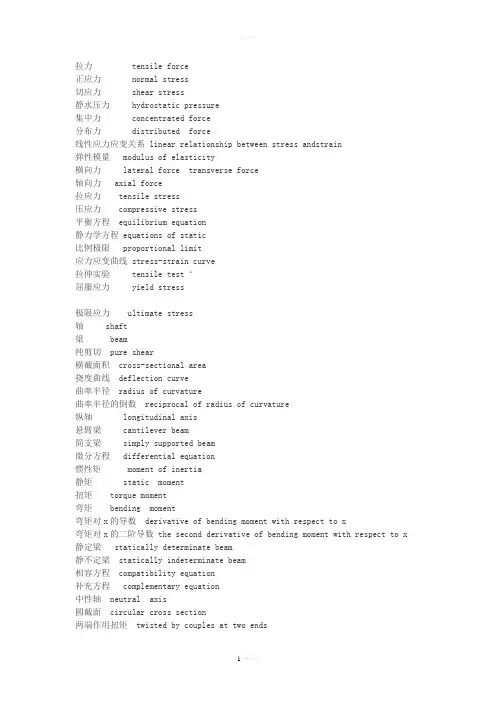
拉力 tensile force正应力 normal stress切应力 shear stress静水压力 hydrostatic pressure集中力 concentrated force分布力 distributed force线性应力应变关系 linear relationship between stress andstrain弹性模量 modulus of elasticity横向力 lateral force transverse force轴向力 axial force拉应力 tensile stress压应力 compressive stress平衡方程 equilibrium equation静力学方程 equations of static比例极限 proportional limit应力应变曲线 stress-strain curve拉伸实验 tensile test‘屈服应力 yield stress极限应力 ultimate stress轴 shaft梁 beam纯剪切 pure shear横截面积 cross-sectional area挠度曲线 deflection curve曲率半径 radius of curvature曲率半径的倒数 reciprocal of radius of curvature纵轴 longitudinal axis悬臂梁 cantilever beam简支梁 simply supported beam微分方程 differential equation惯性矩 moment of inertia静矩 static moment扭矩 torque moment弯矩 bending moment弯矩对x的导数 derivative of bending moment with respect to x弯矩对x的二阶导数 the second derivative of bending moment with respect to x 静定梁 statically determinate beam静不定梁 statically indeterminate beam相容方程 compatibility equation补充方程 complementary equation中性轴 neutral axis圆截面 circular cross section两端作用扭矩 twisted by couples at two ends刚体 rigid body扭转角 twist angle静力等效 statically equivalent相互垂直平面 mutually perpendicular planes通过截面形心 through the centroid of the cross section 一端铰支 pin support at one end一端固定 fixed at one end弯矩图 bending moment diagram剪力图 shear force diagram剪力突变 abrupt change in shear force、旋转和平移 rotation and translation虎克定律 hook’s law边界条件 boundary condition初始位置 initial position、力矩面积法 moment-area method绕纵轴转动 rotate about a longitudinal axis横坐标 abscissa扭转刚度 torsional rigidity拉伸刚度 tensile rigidity剪应力的合力 resultant of shear stress正应力的大小 magnitude of normal stress脆性破坏 brittle fail对称平面 symmetry plane刚体的平衡 equilibrium of rigid body约束力 constraint force重力 gravitational force实际作用力 actual force三维力系 three-dimentional force system合力矩 resultant moment标量方程 scalar equation、矢量方程 vector equation张量方程 tensor equation汇交力系 cocurrent system of forces任意一点 an arbitrary point合矢量 resultant vector反作用力 reaction force反作用力偶 reaction couple转动约束 restriction against rotation平动约束 restriction against translation运动的趋势 tendency of motion绕给定轴转动 rotate about a specific axis沿一个方向运动 move in a direction控制方程 control equation共线力 collinear forces平面力系 planar force system一束光 a beam of light未知反力 unknown reaction forces参考框架 frame of reference大小和方向 magnitude and direction几何约束 geometric restriction刚性连接 rigidly connected运动学关系 kinematical relations运动的合成 superposition of movement固定点 fixed point平动的叠加 superposition of translation刚体的角速度 angular speed of a rigid body质点动力学 particle dynamics运动微分方程 differential equation of motion工程实际问题 practical engineering problems变化率 rate of change动量守恒 conservation of linear momentum定性的描述 qualitative description点线 dotted line划线 dashed line实线 solid line矢量积 vector product点积 dot product极惯性矩 polar moment of inertia角速度 angular velocity角加速度 angular accelerationinfinitesimal amount 无穷小量definite integral 定积分a certain interval of time 某一时间段kinetic energy 动能conservative force 保守力damping force 阻尼力coefficient of damping 阻尼系数free vibration 自由振动periodic disturbance 周期性扰动viscous force 粘性力forced vibration 强迫震动general solution 通解particular solution 特解transient solution 瞬态解steady state solution 稳态解second order partial differential equation 二阶偏微分方程external force 外力internal force 内力stress component 应力分量state of stress 应力状态coordinate axes 坐标系conditions of equilibrium 平衡条件body force 体力continuum mechanics 连续介质力学displacement component 位移分量additional restrictions 附加约束compatibility conditions 相容条件mathematical formulations 数学公式isotropic material 各向同性材料sufficient small 充分小state of strain 应变状态unit matrix 单位矩阵dilatation strain 膨胀应变the first strain invariant 第一应变不变量deviator stress components 应力偏量分量the first invariant of stress tensor 应力张量的第一不变量bulk modulus 体积模量constitutive relations 本构关系linear elastic material 线弹性材料mathematical derivation 数学推导a state of static equilibrium 静力平衡状态Newton‘s first law of motion 牛顿第一运动定律directly proportional to 与……成正比stress concentration factor 应力集中系数state of loading 载荷状态st venant’ principle 圣维南原理uniaxial tension 单轴拉伸cylindrical coordinates 柱坐标buckling of columns 柱的屈曲critical value 临界值stable equilibrium 稳态平衡unstable equilibrium condition 不稳定平衡条件critical load 临界载荷a slender column 细长杆fixed at the lower end 下端固定free at the upper end 上端自由critical buckling load 临界屈曲载荷potential energy 势能fixed at both ends 两端固定hinged at both ends 两端铰支tubular member 管型杆件transverse dimention 横向尺寸stability of column 柱的稳定axial force 轴向力elliptical hole 椭圆孔plane stress 平面应力nominal stress 名义应为principal stress directions 主应力方向axial compression 轴向压缩dynamic loading 动载荷dynamic problem 动力学问题inertia force 惯性力resonance vibration 谐振static states of stress 静态应力dynamic response 动力响应time of contact 接触时间length of wave 波长resonance frequency 谐振频率。
孟庆元工程力学专业英语阅读7
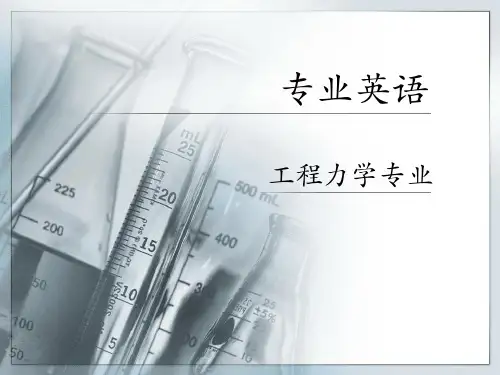
2、 what 作为关系代词,可译为“所…的东西”,“所…的”, 还可根据上下文译成“…的+名词”,“那种+名词”等
What is worrying the world greatly now is a possible shortage of coal, oil, natural gas, or other sources of fuel in the not too distant future.
An element is a simple substance that cannot be broken up into anything simpler.
元素是一种单质,它不能再分任何更简单的物质。
4、that 作为连词引出同位语从句的译法
4.1、同位语从句与主句分译,that译成“即” Energy takes many forms, but all these forms can be reduced
that 作为关系代词,引出定语从句;定语从句可以合译 也可分译,that 的处理方法也随之而异。 3.1、合译时 that 不译,在定语从句之末添“的”字
Power is the rate that mechanical move is performed at. 功率是作机械运动的速率。
3.2、分译时, that 有两种译法: a )重复所代替的名词;b)译成“它” Master is composed of molecules that are composed of atoms. 物质由分子组成,而分子由原子组成。
to the statement that energy is the capacity to do work. 能量具有很多形式,但所有这些形式都可以归纳为这
工程力学全英文Engineering Mechanics (34)
Part II:Mechanics of Materials Combined loadingsCOMBINED LOADINGSObjects of the section:•To analyze the stresses in thin-walled pressure vessels•To develop methods to analyze the stress in members subject to combined loadings(e.g. tension or compression, shear, torsion, bending moments).“Thin wall ”: A vessel having an inner-radius-to-wall-thickness ratio of 10 or more (r/t>= 10).The results of a thin-wall analysis will predict a stress that is approximately 4%less than the actual maximum stressIt is assumed that the stress distribution throughout the vessel’s thickness is uniform or constant.Cylindrical Vessels•A pressure p is developed within the vesselby a contained gas or fluid;•An element shown in the figure is assumedto be subjected to normal stress σ1in thecircumferential or hoop direction and σ2inthe longitudinal or axial direction.•Both stress exert tension on the materialPlane stressFor the hoop stress, the vessel is being sectioned by planes a, b and c.The uniform hoop stress σ1, acting throughout the vessel’s wall, the pressure acting the vertical face of the sectioned gas or fluid.10; 2[( )](2 )0x F t dy p r dy σ=-=∑1pr tσ=It can be imagined as the solidvertical face with p acting.For the axial stress, the vessel is being sectioned by the plane b .The uniform axial stress σ2, acting throughout the vessel’s wall, the pressure p acting the section of gas or fluid. It is assumed that the mean radius r is approximately equal to the vessel’s inner radius.220; (2)()0y Frt p r σππ=-=∑2pr σ=It can be imagined asthe solid section facewith p acting.1pr t σ=22pr tσ=σ1, σ2= the normal stress in the hoop and longitudinal directions, respectively. Each is assumed to be constant throughout the wall of the cylinder, and each subjects the material to tension .p = the internal pressure developed by the contained gas or fluidr = the inner radius of the cylindert = the thickness of the wall (r/t >=10)Spherical Vessels•A pressure p is developed within the vesselby a contained gas or fluid;•An element shown in the figure is assumedto be subjected to normal stress σ2, whichexerts tension on the material.the vessel is sectioned in half using section plane a. Equilibrium in y direction requires:220; (2)()0y F rt p r σππ=-=∑22pr t σ=It can be imagined asthe solid section facewith p acting.THIN-WALLED PRESSURE VESSELS☐Either a cylindrical or a spherical vessel is subjected to biaxial stress.☐The material of the vessel is also subjected to a radial stress σ3, which acts along a radial line. The maximum of it equals to p at the interior wall and decreases to zero at the exterior wall.☐The radial stress σ3will be ignored because σ1and σ2are 5 to 10 times higher than σ3.☐External pressure might cause the vessel to buckle.A member is subjected either an internal axial force, a shear force, a bending moment, or a torsional moment.Several these types of loadings are applied to the member simultaneouslyPrinciple of SuperpositionResultant stress distribution caused by the loads.•A linear relationship exists between the stress and the loads •The geometry of the member should not undergo significant changeAssumptions STATE OF STRESS CAUSED BY COMBINED LOADINGSThe Procedure of Analysisto determine the resultant stress distribution caused by combined loadingsInternal Loadings•Section the member perpendicular to its axis at the point where the stress to be determined and obtain N,M,V and T.•The force components should act through the centroid of the cross section and the moment components should be computed about the centroidal axes .Average Stress Components•Compute the stress component associated with each internal loading.(Distribution of stress acting over the entire cross-sectional area or the stress at a specific point)How?(The neutral axis)NORMAL FORCE P SHEAR FORCE V BENDING MOMENT TORSIONAL MOMENT or THIN-WALLED PRESSURE VESSELS: and SuperpositionOnce the normal and shear stress components for each loadings have beencalculated, use the principle of superposition and determine the resultant normal and shear stress components.x P Aσ=VQ Itτ=y z x z yM z M y I I σ=-+T Jρτ=2m T A t τ=1pr tσ=22pr t σ=Important points (review)☐Pressure vessels: For a thin wall cylindrical pressure vessel with r/t >= 10; the hoop stress is σ1= pr/t. The longitudinal stress is σ2= pr/2t.☐For a thin wall spherical vessels having the same normal tensile stress, which is σ= σ2 = pr/2t.1☐Superposition of stress components: The procedure to analyze the stress state ofa point for a member, which is subjected to a combined loading.Homework assignments: 8-5, 8-15, 8-21, 8-41, 8-54Example 1A force of 15000 N is applied to the edge of the member shown below. Neglect the weight of the member and determine the state of stress at pointsB and C.Solution:1. Internal Loadings. It is sectioned through B and C. For equilibrium at the section, the internal loadings is shown below.2. Stress Components.Normal Force: 150003.75MPa (100)(40)P A σ===Bending moment: The normal force distribution due to bending moment is shown below. 33(40)(100)1212bh I ==N A315000(50)11.25MPa (112)(40)(100)B B My I σ-=-=-=315000(50)11.25MPa (112)(40)(100)c c My I σ=-=-=-yz3. Superposition 3()15000(50)( 3.75)7.5 MPa (112)(40)(100)B B My P I A σ--=-+=-+-=(tension)3()15000(50)( 3.75)15 MPa (112)(40)(100)c c My P I A σ-=-+=-+-=-(compression)Example 2The member shown has a rectangular cross section. Determine the state of stress that the loading produces at point C.Solution:AB F Ax = 16.45 kN; F Ay = 21.93 kN; F B = 97.59 kN1. Internal Loadings. The support reactions on the member have been determined and shown. (Using the equations of equilibrium for the whole member)After the support reactions have known,the internalloadings at section C have been determined and shownin the right figure.2. Stress Components.Normal Force: Shear Force: C C C C It y A V It VQ ''==τSince A= 0, thus Q C = 0, τC = 0 MPa 32.1)250.0)(050.0(45.16===A N C σBending moment: Point C is located aty = c = 125 mm from the neutral axis,so the normal stress at C.MPa 15.63)250.0)(050.0(121)125.0)(89.32(3=⎥⎦⎤⎢⎣⎡==I Mc C σσC =63.15 MPa3. SuperpositionMPa 5.6415.6332.1=+=C σAns.。
孟庆元工程力学专业英语阅读3
最好的导体电阻最小,最差的导体电阻最大。
2、某些句子结构须增加关联词
If A is equal to D, A plus B equals D plus B. 若A = D,则A + B = D + B
G Gr
(2)
Equations (1) and (2) relate the strain and stress at the surface of the shaft to the
angle of twist per unit length.
当一个杆件处于纯扭转状态是,其扭转角沿杆件 纵向方向的变化率(即单位长度的扭转角)d / dx是
sections of the bar remain straight and undistorted during twisting, we see that an
interior element situated on the surface of an interior cylinder of radius is also in
6、补充概括性的词 The frequency, wavelength, and speed of sound are closely related. 频率、波长和声速之间是密切相关的。
The resistance of the pipe to the flow of water through it depends upon the length of the pipe, the diameter of the pipe, and the feature of the inside walls (rough or smooth).
力学专业英语01
力学专业英语01Lessen1Stress and strainThe concepts of stress and strain can be illustrated in an elementary way bu considering the extension of a prismatic bar. As shown in Fig. 1, a prismatic bar is one that has constant cross section throughout its length and a straight axis. In this illustration the bar is assumed to be loaded at its ends by axial forces P that produce a uniform stretching, or tension, of the bar.By making an artificial cut (section mm) through the bar at right angles to its axis, we can isolate part of the bar as a free body [see Fig. 1(b)]. At the left-hand end the tensile force P is applied, and at the other end there are forces representing the action of the removed portion of the bar upon the part that remains. These forces will be continuously distributed over the cross section, analogous to the continuous distribution of hydrostatic pressure over a submerged surface.The intensity of force, that is, the force per unit area, is called the stress and is commonly denoted by the Greek letter δ. Assuming that the stress has a uniform distribution over the cross section [see Fig.1(b)], we can readily see that its resultant is equal to the intensity δtimes the cross-sectional body shown in Fig.1(b),we can also see that this resultant must be equal in magnitude and opposite in direction to the force P. Hence,we obtain.Eq. (1) can be regarded as the equation for the uniform stress in a prismatic bar. This equation shows that stress has units of force divided by area. When the bar is being stretched by the force P, as shown in the figure, the resulting stress is a tensilestress; if the forces are reversed in direction, causing the bar to be compressed, they are called compressive stresses.A necessary condition for Eq.(1) to be valid is that the stress δ must be uniform over the cross section of the bar. This condition will be realized if the axial force P acts through the centroid of the cross section. When the load P does not act at the centroid , bending of the bar will result, and a more complicated analysis is necessary. At present , however, it is assumed that all axial forces are applied at the centroid of the cross section unless specifically stated to the contrary. Also , unless stated otherwise, it is generally assumed that the weight of the object itself is neglected, as was done when discussing the bar in Fig . 1.The total elongation of a bar carrying an axial force will be denoted by the Greek letter δ [see Fi g.1(a)], and the elongation per unit length, or strain, is then determined by the equation.where I is the total length of the bar. Note that the strain ε is a non-dimensional quantity . It can be obtained accurately from Eq.(2) as long as the strain is uniform throughout the length of the bar . If the bar is in tension, the strain is a tensile strain, representing an elongation or stretching of the material; if the bar is in compression, the strain is a compression strain, which means that adjacent cross sections of the bar move closer to one another.When a material exhibits a linear relationship between stress and strain, it is said to be linear elastic. This is an extremely important property of many solid materials, including most metals, plastics, wood, concrete, and ceramics . The linear relationship between stress and strain for a bar in tension can be expressed by the simple equation, in which E is a constant of proportionality known as the modulus of elasticity for thematerial.Note that E has the same units as stress . The modulus of elasticity if sometimes called Young’s modulus,after the English scientist Thomas Young (1773----1829) who studied the elastic behavior of bars. For most materials the modulus of elasticity in compression is the same as in tension.。
力学专业英语25
材料的基本变形当以物体承受荷载,荷载或者来自于作用于外表面的力,或者是重力的影响,或者是类似的施加于整个物体的力,物体产生应力和变形。
对施加于连续体上力的研究形成了连续介质力学。
对连续介质力学问题的公式化表述中,非常重要的一部分是描述作用于单元体上应力和单元体上产生的变形的关系。
在这里,变形意味着物体几何形状的改变。
依赖于工程材料的自然属性和作用力的大小,材料可以以多种不同的方式变形。
它可以以弹性、塑性、粘弹性或者粘性方式变形。
这些变形的每一种形式可以简单定义和描述如下:弹性变形弹性变形可以定义为可逆的变形,也就是,当作用力移除以后,物体可以恢复到它原来的形状,并且所有储存的能量也可以恢复。
任何时候,施加荷载后,不论应力是切应力、正应力或者静水应力,它都会产生相应的弹性变形。
所有,如果给出了作用载荷的大小,那么对应的变形量就可以唯一确定。
其所包含的物理过程是,通过改变原子间的距离,原子键的简单延伸。
几乎所有的晶体材料在相当低的应力下表现为弹性。
部分的没有特定取向晶体聚合物,在低温下基本上也是弹性的。
表征各向同性材料的弹性特性的材料属性是杨氏模量E,切变模量G,体积模量K 和泊松比v。
对于各向同性材料只有两个属性的独立的。
塑性变形塑性变形是永久变形,也就是,在荷载移除之后,物体依然变形并且完成了净功。
包含的物理过程是原子间的滑动,永久的改变了它们相互间的位置。
当作用于金属材料时,正应力并没有显著的影响滑动过程。
所以,它可以表述为只有切应力可以导致金属材料的塑性变形。
变形的维度依赖于加载历史,所以不可以唯一的由应力确定。
包含的一些重要的参数是,塑性变形的切应力和加工硬化率。
对于大多数准静力加载情况,塑性变形是独立于时间,也就是,它不依赖于加载的持续时间。
大多数在高应力下的金属显示出塑性特性。
在高温下,金属承受着依赖于时间的塑性变形叫做蠕变。
粘性变形粘性变形是永久变形,通过变形的时间率来表征,变形是和施加的载荷成比例的。
- 1、下载文档前请自行甄别文档内容的完整性,平台不提供额外的编辑、内容补充、找答案等附加服务。
- 2、"仅部分预览"的文档,不可在线预览部分如存在完整性等问题,可反馈申请退款(可完整预览的文档不适用该条件!)。
- 3、如文档侵犯您的权益,请联系客服反馈,我们会尽快为您处理(人工客服工作时间:9:00-18:30)。
1、应力和应变应力和应变的概念可以通过考虑一个棱柱形杆的拉伸这样一个简单的方式来说明。
一个棱柱形的杆是一个遍及它的长度方向和直轴都是恒定的横截面。
在这个实例中,假设在杆的两端施加有轴向力F,并且在杆上产生了均匀的伸长或者拉紧。
通过在杆上人工分割出一个垂直于其轴的截面mm,我们可以分离出杆的部分作为自由体【如图1(b)】。
在左端施加有拉力P,在另一个端有一个代表杆上被移除部分作用在仍然保存的那部分的力。
这些力是连续分布在横截面的,类似于静水压力在被淹没表面的连续分布。
力的集度,也就是单位面积上的力,叫做应力,通常是用希腊字母,来表示。
假设应力在横截面上是均匀分布的【如图1(b)】,我们可以很容易的看出它的合力等于集度,乘以杆的横截面积A。
而且,从图1所示的物体的平衡,我们可以看出它的合力与力P必须的大小相等,方向相反。
因此,我们可以得出等式(1)可以作为棱柱形杆上均匀应力的方程。
这个等式表明应力的单位是,力除以面积。
当杆被力P拉伸时,如图所示,产生的应力是拉应力,如果力在方向是相反,使杆被压缩,它们就叫做压应力。
使等式(1)成立的一个必要条件是,应力,必须是均匀分布在杆的横截面上。
如果轴向力P作用在横截面的形心处,那么这个条件就实现了。
当力P没有通过形心时,杆会发生弯曲,这就需要更复杂的分析。
目前,我们假设所有的轴向力都是作用在横截面的形心处,除非有相反情况特别说明。
同样,除非另有说明,一般也假设物体的质量是忽略的,如我们讨论图1的杆一样。
轴向力使杆产生的全部伸长量,用希腊字母δ表示【如图1(a)】,单位长度的伸长量,或者应变,可以用等式来决定。
L是杆的总长。
注意应变ε是一个无量纲的量。
只要应变是在杆的长度方向均匀的,应变就可以从等式(2)中准确获得。
如果杆处于拉伸状态,应变就是拉应变,代表材料的伸长,那么应变就是压应变,这也就意味着杆上临近的横截面是互相靠近的。
当材料的应力和应变显示的是线性关系时,也就是线弹性。
这对多数固体材料来说是极其重要的性质,包括多数金属,塑料,木材,混凝土和陶瓷。
处于拉伸状态下,杆的应力和应变间的线性关系可以用简单的等式来表示。
E是比例常数,叫做材料的弹性模量。
注意E和应力有同样的单位。
在英国科学家托马斯·杨(1773 ~ 1829)研究杆的弹性行为之后,弹性模量有时也叫做杨氏模量。
对大多数材料来说,压缩状态下的弹性模量与处于拉伸时的弹性模量的一样的。
2、拉伸应力应变行为一个特殊材料中应力和应变的关系是通过拉伸测试来决定的。
材料的试样通常是圆棒的形式,被安置在测试机上,承受拉力。
当载荷增加时,测量棒上的力和棒的伸长量。
力除以横截面积可以得出棒的应力,伸长量除以伸长发生方向的长度可以得出应变。
通过这种方式,材料的完整应力应变图就可以得到。
图1所示的是结构钢的应力应变图的典型形状,轴向应变显示在水平轴,对应的应力以纵坐标表示为曲线OABCDE。
从O点到A点,应力和应变之间是直接成比例的,图形也是线性的。
过了A点,应力应变间的线性关系就不存在了,因此A点处的应力叫做比例极限。
随着荷载的增加,应变比应力增加的更快,直到在B点,在拉应力没有明显增大的情况下,物体也发生了相当大的伸长。
这种现象叫做材料的屈服,点B处的应力叫做屈服点或者屈服应力。
在区域BC材料开始具有塑性,棒也开始塑性伸长,伸长量是在比例极限处伸长量的10或者15倍。
在C点,材料开始应变硬化,并且进一步的阻力,阻止载荷的增加。
这样,随着进一步的伸长,应变增加,并且在D点达到最大值,或者极限应变。
过了这一点,棒的拉伸伴随着载荷的减少,试样最后在图上E点断裂。
在棒伸长期间,发生了侧面的收缩,导致棒的横截面积减小。
这个现象在C点之前,对应力应变图没有影响,但是过了这一点,面积的减小对应力的计算值有明显的影响。
棒就会发生明显的颈缩(如图2所示),并且如果颈处狭窄部分的实际横截面积被用于计算σ,将会发现真实的应力应变曲线是虚线CE。
尽管在极限应力达到之后,棒上的总荷载有实际的减小,这个减小是由于面积的减少,而不是材料强度的减小。
在失效点之前,材料实际经受了应力的增加。
然而,为了多数实用目的,常规的应力应变曲线OABCDE是基于试样最初的横截面积,为设计目的提供了令人满意的信息。
图1的图形,画出来是为了表示应力应变曲线的一般特性。
在应力应变曲线的最初区域,材料表现的既有弹性又有线性。
钢材的应力应变图上的从O到A的区域就是很好的例子。
紧接着大的塑性应变,明显屈服点的出现,对于在今天是很普通的结构化金属——钢材来说稍微有点独特。
铝合金从线性到非线性区域是更渐渐的转变。
在失效之前,钢和许多铝合金承受了更大的应变,所以被归类为易延展的。
另一方面,脆性材料在很低的应变时就失效了。
实例包括陶瓷,铸铁,混凝土,某些金属合金,和玻璃。
3、圆棒的扭转让我们设想一下,一个具有圆形横截面的棒被作用在其末端的力偶扭转(如图1)。
以这种方式加载的棒据称是处于纯扭转。
从考虑对称性可以看出,圆棒的横截面在纵轴方向是作为刚体扭转的,半径依然是直的,横截面是圆形的。
并且,如果棒扭转的总角度比较小的话,棒的长度和半径r都不会改变。
在扭转期间,对应于棒的一端,棒的另一端绕着纵轴会发生扭转。
例如,如果我们把棒的左端看做固定的,那么对应于棒的左端,棒的右端会旋转一个角度。
同时,棒表面的纵向线例如nn,会旋转一个小的角度到位置。
因为扭转,棒表面的矩形单元,例如图中所示的在两个横截面之间相距的单元,被扭转成长菱形。
当一个杆状物承受纯扭转时,扭转角的变化率沿着棒的长度方向是恒定L是轴的长度。
然后,我们可以得到切应变。
作用在单元边线处的切应力有图1所示的方向。
对于线弹性材料,切应力大小是。
等式(1)(2)把杆状物的应变和应力与单位长度的扭转角联系起来。
杆状物内部的应力表述用的方式类似于用于杆状物表面的表述方式。
因为棒横截面的半径依然是直的,在扭转时没有扭曲,我们看到位于半径为ρ的圆柱体表面的内部单元,是纯剪切并伴随着对应的切应变,应力可以从下述的表达式得出。
这些等式表明,从轴心处切应力和切应变随着径向距离是线性变化的,并且在外表面达到最大值。
作用在横截面的切应力,由等式(3b)给出,伴随着作用在杆状物纵向平面的相等的切应力。
这个结果是从这样一个事实得到的,就是相等的切应力总是存在于相互垂直的平面。
如果材料纵向受剪弱于侧向受剪(例如,木材),受扭杆状物的第一次断裂将会出现在它的纵向表面。
杆状物表面的纯剪切应力的表述等效于,对于杆状物轴扭转45。
的单元上的拉应力和压应力。
如果一种受拉比受剪弱的材料受扭,那么材料将会沿着与轴成45。
的螺旋线处以收缩的方式失效。
通过扭转一支粉笔的方式就可以很容易的演示这种失效。
可以建立施加的扭矩T和产生的扭转角间的关系。
切应力的合力必须静定的等于合扭矩。
作用在单元面积dA上的剪切力是,这个力对于棒轴的力矩是。
在等式(3b)中,力矩等于。
合力矩T是整个横截面上的单元力矩的总和,因此,总和,因此,是圆截面的极惯性矩。
从等式(4)我们可以得到,是单位长度的扭转角,与扭矩T成正比,与乘积,是相反的,是杆的扭转刚度。
4、梁的挠曲一根承受轴横向力的棒叫做梁。
图1中的梁,一端是针状支撑,另一端的滚动支撑,叫做简支梁或者简单的梁。
简支梁的本质特征是在弯曲时梁的两端可以自由转动,但是它不能够横向移动。
另外,梁的一端可以沿轴向自由移动。
一端是嵌入式或者固定,另一端的自由的梁,叫做悬臂梁。
梁的固定端既不可以转动也不可以移动,自由端则可以转动和移动。
梁上的荷载可以分为集中力,例如图1横截面的质心。
剪力??被叫做合应力。
荷(或者没有载荷)作用于梁上时,弯矩的变化率等于剪力的代数值。
如果梁上作用有集中力,那么在集中力作用点剪力处,将会有突变,或者不连续。
梁的纵轴是直的。
在弯曲后,梁的轴变成了曲线,表现为曲线,让我们假设xy平面是对称与梁的平面,并且所有的载荷都作用在平面内。
那么曲线,叫做梁的挠曲线,也会在平面内。
从图形的几何形状可以看出,是曲率,等于曲率的半径的倒数。
这样,曲率等于角度在沿着挠曲线测量的长度方面的变换率。
梁挠曲线的基本微分方程可以表述为,是梁从初始位置的挠度。
必须在每个事例中求积分来获得挠度。
这个步骤包括方程的连续积分,作为结果的积分常数从梁的边界条件获得。
应该明白,只有在材料适用于胡克定律并且挠曲线的斜率是很小的时候,方程才是有效。
另一种获得梁挠度的方法是力矩面积法。
这个方法得名于它利用了弯矩图的面积。
当想得到挠度或者梁上一点处的斜率,而不是获得挠曲线的整个方程,这个方法是特别有用的。
是在横截面中性轴方面的第二力矩(或者惯性矩),Q是梁平面面积的第一力矩(或者静态矩)。
可以看出梁外缘处正应力是最大的,在中性轴处为零,在外缘处切应力为零,在中性轴处经常达到最大。
梁上的剪力V和弯矩M经常随着距离变化,距离规定是从它们作用在梁上的横截面处开始的。
当设计一个梁时,非常想知道梁上所以横截面处和的值,提供这方面信息的一个很简便的方法是画一个表达它们沿着梁轴变化的图。
为了画出图,我们把横截面的位置作为横坐标,把对应的剪力或者弯矩的值作为纵坐标。
这样的图像叫做剪力图或者弯矩图。
图1中的简支梁是静定梁中的一种。
这种梁的特征的它所有的反作用力都是由静力平衡方程决定的。
反作用力的数目多于静力平衡方程数目的梁叫做超静定梁。
对于静定梁,我们可以通过求解静力平衡方程快速获得梁的反作用力。
然而,当梁是超静定时,我们不能仅从静力方面求解解决。
取而代之的是,我们必须考虑梁的挠度,并且获得相容方程作为静力方程的补充。
6、刚体的平衡静力学的主要目标是建立一个基本理论,来管理作用在处于平衡状态的物体上的力。
描述阻止物体移动的力的一个手段是自由体受力图,它使物体从周围的事物中隔离出来。
在受力图中,我们展示了施加在物体上的所有力,记住牛顿第三定律告诉我们的,力是物体之间相互作用的结果。
构建受力图的过程帮助我们理解系统的参数是很重要的。
构建自由体受力图的部分任务的为了检查支撑结构,以便我们可以推导出应用在物体上的什么类型的力。
这些力有时叫做约束力,因为它们代表支撑结构约束物体移动的方式。
对这些力的另一个术语是反作用力,因为它们代表支撑结构对物体移动趋势做出反应的方式。
反作用力被用来约束物体的移动,反作用力偶被用来约束物体的转动。
在任何时候支撑结构的类型允许物体在特定方向移动,或者是绕着特定轴转动,那么在哪个方向将没有反作用力或力偶。
我们可以为条件建立一个数学推导公式,如果物体处于精力平衡状态,那么这个公式必须满足。
在我们研究作用在处于静力平衡的物体上的力之间的关系之前,让我们想象用作用在一些合适点C的等效的力偶系,来代替作用在物体上的真实的力。
